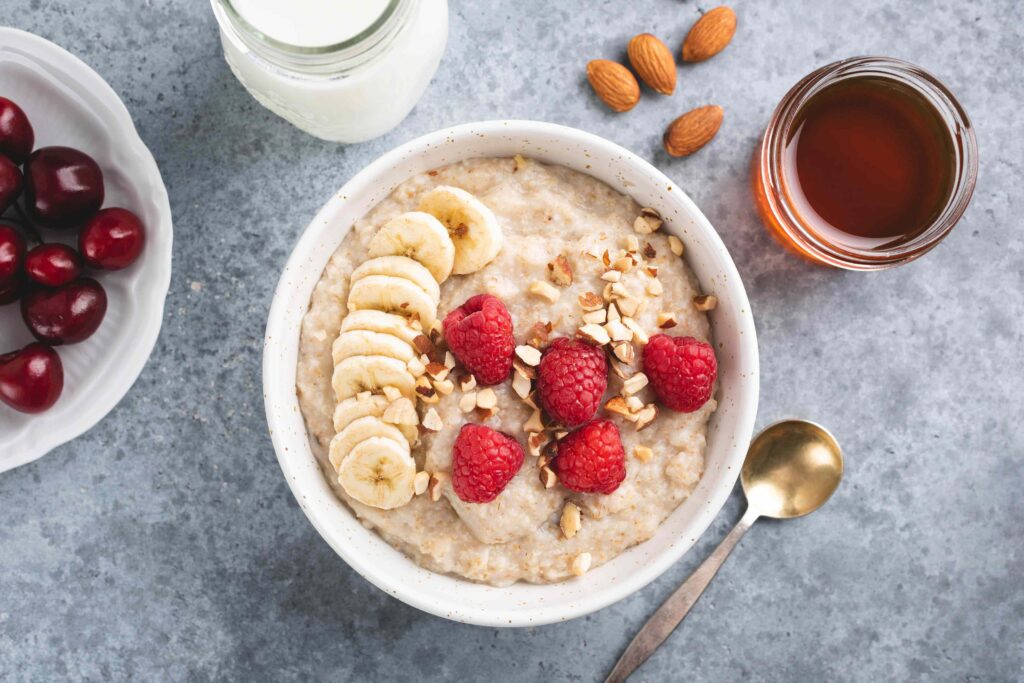Oatmeal is a popular breakfast staple. It contains some protein and fiber, which may help promote weight loss by increasing fullness and satisfaction. The way you prepare your oatmeal can make the difference between a nutritious option for weight loss and a meal that may slow your progress.
Oatmeal is rich in several nutrients, making it a smart choice for weight loss. Here’s how incorporating oatmeal into your diet may help you stay satisfied, manage cravings, and support your health goals:
- High in fiber: Oatmeal is a good source of beta-glucan, a type of soluble fiber that mixes with water to form a gel-like substance in the digestive system. This helps you feel fuller for longer, which can support weight management. Soluble fiber also plays a role in regulating blood sugar and lowering cholesterol levels. One study found that people who ate oatmeal for breakfast felt more satisfied and were less likely to snack afterward than those who ate only oranges.
- Low glycemic index (GI): The glycemic index measures the impact of a food on blood sugar levels. The higher the GI, the greater the impact on blood sugar. Oatmeal made from steel-cut or rolled oats has a low GI, meaning it provides a slow, steady release of energy. This can help stabilize blood sugar, curb cravings, and reduce the likelihood of overeating.
- Supports healthy digestion: The fiber in oatmeal helps keep your bowel movements regular and supports the growth of beneficial gut bacteria that may help protect against obesity. However, more human research is needed to confirm these findings.
How you prepare oatmeal may impact its nutritional value, which could affect your weight loss goals. Here are some things to keep in mind:
- Added sugar: Many flavored instant oatmeal packets contain added sugar, with as much as 12 grams or more per packet. This adds extra calories without any nutritional benefit. Diets high in added sugar can also increase the risk of heart disease.
- High-calorie toppings: While toppings like brown sugar, maple syrup, granola, or dried fruit can add flavor and nutrients, they can also increase the total calorie count.
- Portion control: Start with a serving of about 1 cup cooked oats (around 150 calories). This leaves room to add more calories from protein and toppings like nuts, seeds, or nut butter to help you stay full.
To make oatmeal work for your weight loss goals, try these strategies:
- Choose unflavored oats: Opt for unsweetened instant, rolled, or steel-cut oats, all of which provide whole grains and similar nutrition benefits. Flavor with low-calorie sweeteners, cinnamon, vanilla extract, or fresh fruit to add taste without too many extra calories.
- Watch your portions: Stick to about a half cup of dry oats per serving. If you need more volume, add low-calorie, high-fiber foods like berries or chopped apples.
- Add protein and healthy fats: While oatmeal does contain some protein, it is not considered a high-protein food. To make oatmeal more balanced, add a scoop of Greek yogurt, a sprinkle of chia seeds, egg whites, or a teaspoon of nut butter. Protein and fat help stabilize blood sugar and keep you full.
- Try savory oatmeal: Make a savory oatmeal bowl with spinach, a soft-boiled egg, or a sprinkle of cheese.
- Start slow: If you’re new to oatmeal or a high-fiber diet, introduce it gradually and drink plenty of water to avoid bloating and discomfort.
- Serve it cold: Try overnight oats for a convenient, make-ahead option.
Oatmeal can be a healthy choice, but some people may need to be more cautious when including it in a weight-loss diet. This includes:
- People with oat allergies: Though rare, an oat allergy can cause symptoms like stomach upset, hives, or trouble breathing.
- People with celiac disease: Oats are naturally gluten-free, but they’re often contaminated with gluten during processing. Only certified gluten-free oats are safe for people with celiac disease.
- People following a low-fiber diet: If you have certain medical conditions or are having surgery, your healthcare provider may recommend a low-fiber diet to give your bowels time to rest.
- People with diabetes: Oatmeal can raise blood sugar, especially when paired with sweet toppings. Monitoring your portions and pairing oats with a protein or fat can help keep blood sugar more stable.
If you fall into one of these groups, talk with a healthcare provider or dietitian before making oatmeal a regular part of your diet.


